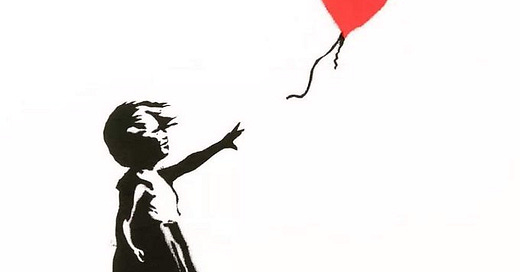This photo was shared by an X user OpenSkiesX.
Here is part of my thoughts about this picture:
WIND
The hair indicated that a wind was blowing towards the right side of the picture. If this is true, I would have preferred for the string of the balloon to sway towards the right instead of the left side. The dress (if it is a light material) should be more body-hugging at the helms - to demonstrate the strength of the wind.
STANDING & NOT RUNNING
The girl stood with her 2 feet together, which is a posture of standing. Thus, it is more of a case of letting go than that of losing the balloon. If any kid is to lose the balloon, an expected reaction would be to chase after the balloon - a posture that can be represented with one leg forward and the other back.
LETTING GO
Yet, I am not completely sure if it is letting go. If we let a balloon fly away from our hands, some culture adopts a culture of opening our palms facing upwards (with somewhat of consent). In this picture, the girl lets go of the balloon with her palms facing downwards. This can likewise suggest unwillingness.
MINORITY
The girl belongs to a minority as she is left-handed (the hand which lets go of the balloon). The eyes of the girl were looking slightly towards a 2 o'clock bearing and the wind was blowing in a direction of 3 o'clock. Thus, the above scene is possible (scientifically).
PERSPECTIVE (pity or envy)
The angle of the artist’s view is on par towards the girl. There is no looking down (where some artists imply pity) or looking up (where some artists imply envy). To send a strong message of "envy" or "pity" I would tilt the angle of the drawing. Yet, the artist chose to be on the "same standing" in terms of perspective for the girl, it could be a common sentiment - from that of a contemporary or similar social status. To create a bigger impact, I prefer a bigger distance between the girl and the balloon that will magnify the importance of the balloon and with that a sense of loss.
ALONE
In most cultures, kids at such a young age are not left alone. Could this imply a "weak" or dysfunctional family structure? Did this happen during abnormal times? Could it be a time of turmoil like war, or after a man-made disaster?
MONOCHROME AND MESSAGE
By the choice of a white background and most other items in monochrome, there is no intent to create a sense of depth and thus, the message was meant to be delivered "hard and fast" - as the audience is not required to go through the details of the background, setting, or clothes on the little girl. This removes the context of a place, language, culture or race. These have become non-essential - thus they carry a message meant for the masses.
HAIR
For young girls, short hair can be a choice of convenience (due to living conditions) or necessity. Typically, we have a stereotype of a girl with a good life seen with “long hair”. There are not many details of the dress. There are no embellishments or ornaments - we see no ribbon, or bracelets which imply basic or essential. This has a subtle implication of the average "income bracket" of the family and yet, there are no holes in the dress (a "helpful" signal of distress or poverty).
PANTS
The other detail that caught my eye was that the little girl was wearing long pants underneath the dress. This represents cold weather or a rough condition. In times of distress, what we wear is essential. With no time to pick up our favourite clothing, our dressings is highly functional without excessive ornaments. Yet, the girl has access to balloons. This is a luxury during difficult times that demonstrates love, kindness and generosity.
FORESHORTENING
In terms of foreshortening, the right arm of the girl seems smaller than the left arm. This may imply some handicap or maybe a different focus for the artists. Typically, for 2 similar items, the one that is in closer proximity should appear bigger and the one further away should appear smaller in contrast.
CONCLUSION
People see what we want to see and hear what we want to hear. Sometimes, we should allow the picture to speak to us. I was blessed to have spent years studying Fine Arts. Though, I am no longer a practitioner. Yet, many of the historical & cultural lessons have become part of my perspective and value system. Art has never left me and I kept growing in Art through her various expressions.
In all our pursuits, let us get understanding. This is the first step towards peace, kindness and respect.
Behind every art or post, there are delivery, content and intent.
Let us enjoy the journey beyond enjoying the delivery and content. Some of the intent can be subtle and some could be “selfish”. Thus, let us learn to read through all these in our world where there is so much propaganda, mass marketing and branding.



